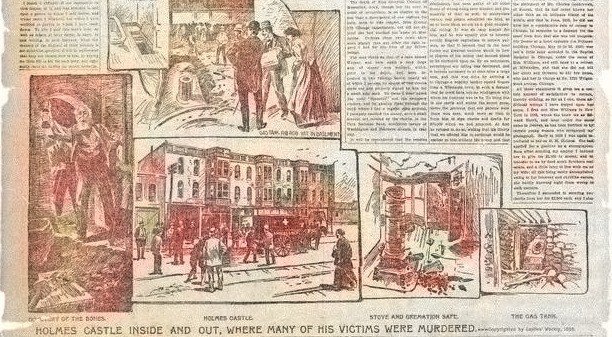Reputedly, America’s first serial killer is H.H. Holmes. Born as Herman Webster Mudgett in 1860, this depraved man was also intelligent, debonair, charming, and funny. He made a living on humans and built a “murder castle” in Englewood, Chicago where he killed his victims and processed their bodies. Although he confessed to 27 murders, experts estimate it may have been in the hundreds. This would make Holmes one of the worst serial killers in the U.S.
[blockquote align=”none” author=”Holmes”]But to think that I committed this and other crimes for the pleasure of killing my fellow beings, to hear their cries for mercy and pleas to be allowed even sufficient time to pray and prepare for death—all this is now too horrible for even me […].[/blockquote]
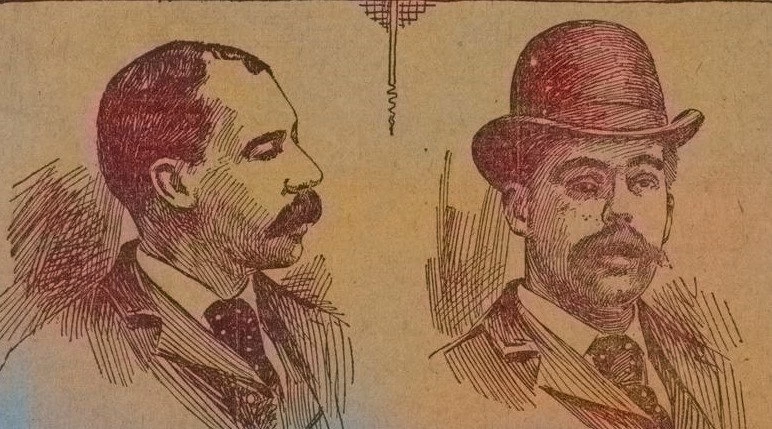
Mug sketch at the final arrest of Henry Howard Holmes. 1996. Image: Library of Congress.
The Early Life of H.H. Holmes
Mudgett was born into wealth in Gilmanton, New Hampshire. During adolescence, he got himself into trouble on more than one occasion. Despite all of this, he performed well in school.
In 1878, he began his studies in medical school. He married Clara Lovering, the daughter of a prosperous farmer in New Hampshire. During college, he discovered a way to remove corpses from the laboratory. He would disfigure the body and set it up to make it look like an accident occurred. Then he collected an insurance policy he had taken out on these “relatives.” The most he ever earned from this insurance fraud was $12,500.
Life in Chicago
Marriage to Clara did not work out, and she moved home. While he was moving to Chicago, he went from place to place, committing many insurance fraud scams. He took the alias Henry Howard Holmes to avoid detection and finally reached Chicago in 1885. Although he tried to file for divorce from Clara, the divorce proceedings failed. Nonetheless, he married a local woman in Chicago, Myrta Belknap.
The Dating Game Killer Rodney Alcala
In the suburb of Englewood, Mrs. D. Holden owned a shop. Holmes answered her employment ad and got the job as a clerk. Holden and the customers loved him with his sense of humor and radiant charm. It seemed as though he was even attracting new customers to the store. For this reason, when Holden vanished one day, everyone was surprised. Holmes told police that he bought the store from her and she retired and left the area with no forwarding address.
The World’s Fair Hotel
Some years after buying Holden out, Holmes brokered a deal to buy some land directly opposite his shop and began construction on a mixed-use, three-story building in 1887. The budding businessman appointed himself as the architect.
Meanwhile, the 400th anniversary of Columbus’ arrival in the New World was coming up in 1893. A massive celebration would take place at the Columbian Exposition World’s Fair just three miles from his new building. Twenty-seven million people from all over the world would flock to the city. Holmes planned to use his new building as a hotel because Chicago would become something of a boomtown for the duration of the fair. It was called, “The World’s Fair Hotel.”
One of the stores he opened on the lower level of the building was a jewelry counter. Holmes hired a professional jeweler and watchmaker, Ned Connor, to help out with this new venture. Connor arrived with his lovely partner, Julia, and her daughter, Pearl. Holmes noticed Julia. He quickly fired his current bookkeeper for no real reason and gave Julia the job. A romance sparked between Julia and Holmes. Consequently, Connor walked out on Julia, and she got custody of Pearl.
Curiously, Julia and her daughter disappeared in 1891. Mudgett said that Julia had died during an abortion.
Features of the Murder Castle
According to History, the newspapers of the day likely published articles embellished with sensational elements about the building. Therefore, the following description may or may not be factual. Reports indicated that Holmes’ building had 60 rooms and 51 doors. The entire first floor consisted of stores and shops. Ingeniously, one of those was a drug store with a pharmacy. Holmes had worked as a druggist in the past and knew how certain drugs might come in handy.
Many features of the building lay at odd angles. Some of the rooms did not have a window, while others had concealed trap doors. Several staircases hid behind walls. One of them led to a sheer drop onto an alley that was at the back of the building. A chute led directly into the basement where he kept acid vats and pits filled with quicklime next to a surgery table. Additionally, there was an incinerator for cremations.
Holmes had converted one room upstairs into his office space. Additional macabre secret designs hid within the walls of the castle. Several of the guest rooms were “asphyxiation chambers” with gas vents, which Holmes controlled from the closet in his bedroom. Other rooms had iron plates, asbestos lining the walls, and blowtorches. Each room contained an alarm system that would alert the owner to any possible escape.
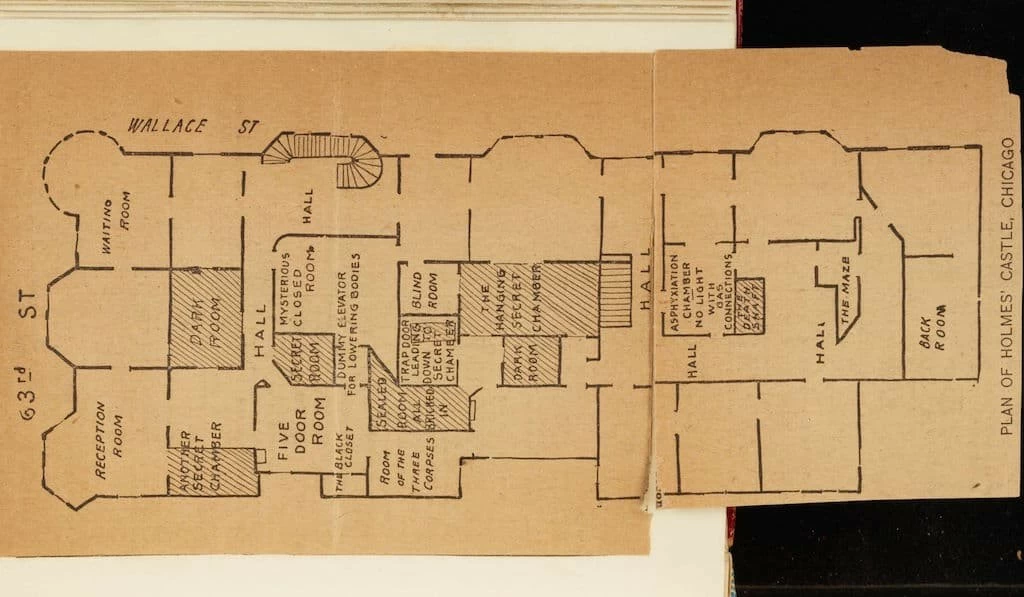
Plans for Holmes’ Castle. Image: Holmes’ Own Story.
[blockquote align=”none” author=”Cecil Adams, Straight Dope”]He also had a well-equipped surgery area equipped with the usual medical apparatus as well as several instruments of torture, such as the rack. Human fragments, including several complete skeletons, were discovered here and throughout the premises.[/blockquote]
The hotel was ready for business in 1892. Holmes advertised his hotel in anticipation of the upcoming World’s Fair in the White City center.
Minnie Williams
In 1893, H.H. Holmes met a plain young lady by the name of Minnie Williams. She didn’t have the good looks that most of his previous lovers and spouses possessed. However, Minnie had inherited a fortune in Texas real estate. Unfortunately, she was a naive person with a rather child-like mind, and this made her the perfect victim. Holmes zoned in on this fact and hired Minnie as his secretary. Naturally, he wooed her, and before she knew it, he had asked her to marry him. It wasn’t long before she was giving him large sums of money and signing her Texas property over to him.
The couple lived in an apartment together, where Holmes spent a great deal of time getting to know Minnie. He learned that she also had a sister who was an heiress to a vast fortune, and he urged Minnie to invite her sister for a visit.
In July 1893, the plans were in place for Nannie to visit Chicago, and she had left her Southern home by train. Holmes went alone to the depot to pick her up. When she arrived, he told Nannie that Minnie was waiting for them and promptly escorted her to his building. He used his perverse methods to get her to sign over her wealth, and then he quickly proceeded to kill her without a trace. Subsequently, he faked a letter to make Minnie think Nannie never left the South.
Later that same year, Holmes took Minnie to Momence, Illinois, where he killed her and buried her body in the basement of a house. In her belongings, he found an insurance policy. Minnie’s brother had taken out life insurance, and Minnie was the beneficiary. Out of his lust for money, Holmes traveled to Leadville, Colorado, to shoot her brother. He then forged Minnie’s signature and collected the life insurance.
(Note: There are conflicting stories about what happened to Nannie. This version originates from the confessions of Holmes in Holmes’ Own Story).
Holmes’ Scams
In October of 1893, H.H. Holmes would carry out another scheme for a large sum of money. He had taken out four fire insurance policies on his hotel worth $25,000. The fire destroyed the third level, but most of the second floor was still intact, and the ground-floor businesses were unharmed. The investigation pointed to arson. Therefore, the insurance companies suspected fraud, and they refused to pay.
Ben Pitezel was a long-time employee and friend of Holmes and had been his wingman on a few scams in the past. Holmes hatched out another plan with Pitezel that would involve an insurance policy on Pitezel’s life. The beneficiary would be Carrie Pitezel, Ben’s wife. First, Holmes would take out an insurance policy of $10,000.
Then after some time, they would fake Pitezel’s death, substitute a corpse for his, and split the proceeds. This time, Holmes had to use an out-of-town life insurance company, due to his suspicious reputation in Englewood. Fidelity Mutual Life Association of Philadelphia, Pennsylvania, happily sold the dapper doctor a policy. Now they had to wait.
Meanwhile, lenders were bearing down on H.H. Holmes. He owed nearly $50,000, and in light of the fire and an economic downturn, they wanted their money. Additionally, life insurance companies were suspecting him of fraud, and rumors were spreading around town that made it hard for him to procure more insurance policies. In July 1894, Holmes, Pitezel, and Holmes’ current wife, Georgiana Yoke, left Chicago to Fort Worth, Texas, to liquidate the property he took from Minnie.
Things didn’t work out as planned with the property. However, they committed some other scams. When the two men stole Texas bloodline horses from some Texan ranchers, the authorities began their hunt. Police caught up with him in St. Louis, but Holmes posted bail almost immediately. During his time in jail, he had made another plan with his cellmate Marion Hedgepeth, a rough and mean outlaw doing 25 years for train robbery.
A Deadly Plot
H.H. Holmes intended to commit insurance fraud to the tune of $20,000 and needed the name of a corrupt lawyer to pull it off. Hedgepeth provided the name of attorney Jeptha Howe for a fee. When Holmes presented his ideas to Howe, the attorney considered it to be brilliant. Holmes planned to fake his own death and collect the insurance.
He took a corpse to a beach in Rhode Island, lit it on fire, and left it on the beach until someone found it. Holmes had a full shave and altered his appearance before he returned to a hotel and registered with a new alias. When he heard that someone had found the corpse, he formally identified it as Holmes and tried to cash in the policy. The life insurance company suspected fraud and refused to pay. So, conman returned to Chicago and decided he would work on his Pitezel scheme.
Holmes drafted the assistance of both Ben Pitezel and Jeptha Howe. Pitezel and his wife, Carrie, traveled to Philadelphia and opened up a brand new shop that sold patents under the name B.F. Perry. This was a name that Holmes used on yet another new insurance policy. In Philadelphia, Pitezel would drink a potion designed to render himself unconscious. H.H. Holmes would apply makeup to him and convince an independent witness that this was a man that had died of severe burns. While the witness left to call for an ambulance, the pair would switch Pitezel out with a real corpse. Holmes offered Pitezel a percentage of the payout for his part in this scam.
On September 4, neighbors near the patent office heard a loud explosion. Not long afterward, a local man arrived at the office and found the doors locked and the place dark. Immediately, he called the police. When they arrived at the scene, the first responders kicked down the door and discovered a badly burned man. Holmes had killed Pitezel. The insurance company considered his death an accident, but they required identification of the body before they would pay.
Collection of the Pitezel Insurance
Jeptha Howe, Pitezel’s 15-year-old daughter, and H.H. Holmes went to Pennsylvania together. The poor daughter identified some markings on Pitezel’s body and some of his teeth. Subsequently, the insurance company paid out the cash, and Howe kept $2500 of it. Holmes took the remainder and presented Carrie with just $500, which he promptly took back and promised to invest it for her. Marion Hedgepeth did not receive anything for his part in the fraud. In a remarkable double-cross, Holmes did murder his accomplice.
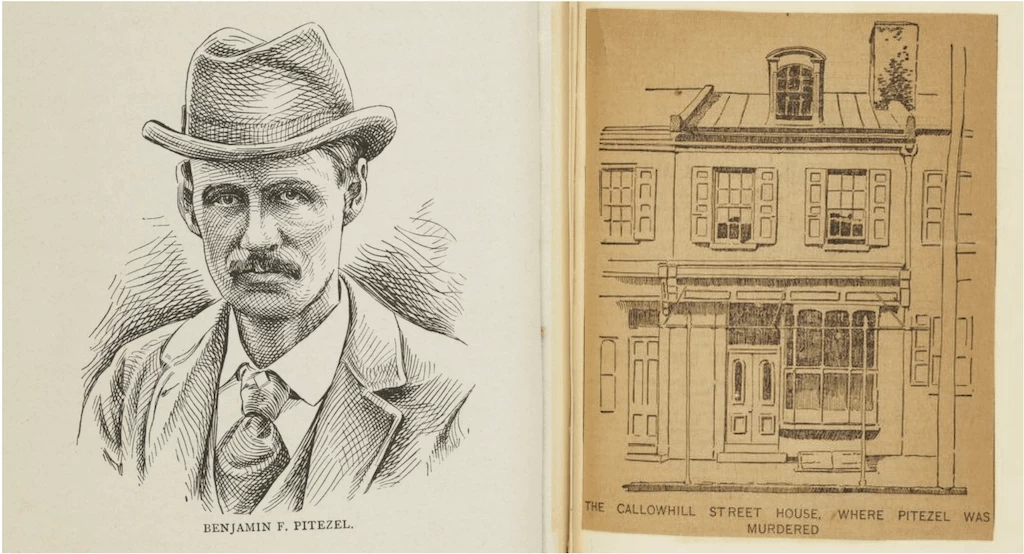
Benjamin Pitezel and the place of his murder. Images, LoC. Compilation: Historic Mysteries.
H.H. Holmes didn’t even bother to get in touch with Hedgepeth once the plan was complete. Naturally, Hedgepeth didn’t appreciate the snub — or the lack of payment. Hedgepeth sat on his inside knowledge for a short time before eventually opting to snitch on Holmes. Hedgepeth contacted local police officer Lawrence Harrigan. Then, Philadelphia police detective Frank Geyer entered the investigation.
Meanwhile, Holmes knew he needed to run. He fed Carrie a slew of lies and convinced her to head east with him and Georgiana, where, as he told her, Carrie would meet up with Ben. Of course, that would never happen. They traveled from city to city until Holmes finally instructed Carrie to continue without him. He would head to Canada with three of her children while she went to meet Ben.
In July 1895, Frank Geyer found the bodies of Alice and Nellie Pitezel buried in the basement of a house that Holmes had rented in Toronto, Canada. Later, the remains of the third child, 7-year-old Howard Pitezel, turned up in a home in Irvington, Indiana. The monster of a man had cut up the poor boy’s body and stuffed and burned the parts in the stove.
Back in Philadelphia, Fidelity Mutual Insurance had hired the most famous private investigators in the United States, Pinkerton Agency, to track Holmes. He was aware that detectives were shadowing his every move. For two months, he avoided capture, but his luck ran out on November 17, 1894. Henry Holmes arrived in Boston at his parents’ home, where the Pinkertons promptly arrested him.
Bodies in the Murder Hotel
Detectives found a house of horrors at H.H. Holmes’ hotel. According to possibly sensational reports from the time, the basement contained blood-splattered dissecting tables that sat alongside various torture paraphernalia and pristine surgical instruments. A crematorium contained ash and remnants of human bones. Additionally, Minnie Williams’ watch and other pieces of jewelry also lay within the ash. A pelvic bone belonging to a young child turned out to be that of Julia’s daughter, Pearl. Julia had also perished in the hotel, as investigators found a bloody piece of her dress. Numerous ribs and part of a skull still bobbed in the vat of acid. More skeletons lay inside two pits on the floor, and an additional three skeletons under the dissecting table were awaiting their sale to one of the medical schools.
How Burke and Hare Killed and Sold Humans as Cadavers
On August 19, shortly after midnight, a trio of explosions rocked the neighborhood. Within just an hour, the roof caved in and eventually brought the walls down too. Among the ruins was a discarded gas can. Witnessed claimed to have seen two men go into the building and, 30 minutes later, running out. People were thrilled that the infamous Murder Castle was destroyed.
Trial and Execution
H.H. Holmes confessed. He claimed that he killed 27 people, but police could only confirm nine, according to the evidence at the hotel. Others estimated that he killed up to 200 people. The trial began not long before Halloween in 1895 and lasted for less than a week. Supposedly, the jury only required two hours to find Chicago’s White City murderer guilty. America’s most famous serial killer of all time was hanged at Moyamensing Prison on May 7, 1896.
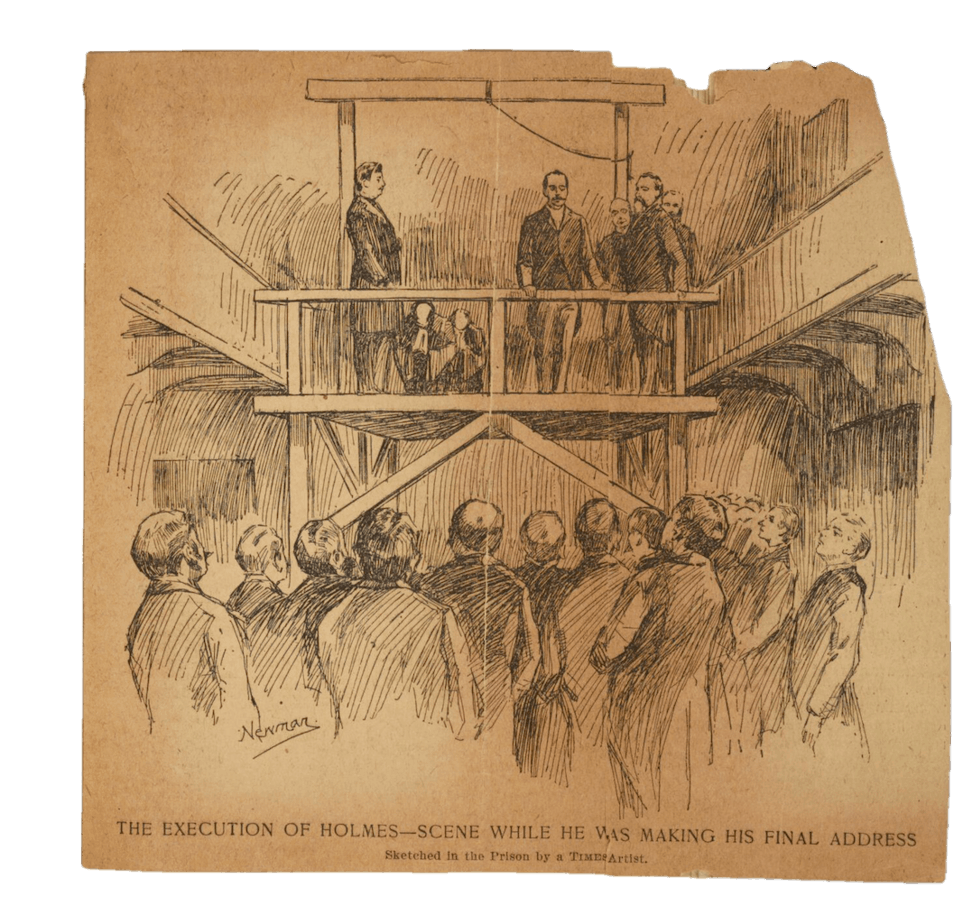
Subsequently, he was buried at the Holy Cross Cemetary in Landsdowne, Pennsylvania. He had requested a concrete casket because he believed people would desecrate his grave. The bigamist left behind three spouses and two children, Robert Lovering Mudgett (son of Clara) and Lucy Theodate Holmes (daughter of Myrta).
Upcoming H.H. Holmes Movie
In 2010, Leonardo DiCaprio acquired the film rights to a book by Erik Larson, The Devil in the White City. Rumor has it that DiCaprio and Martin Scorsese are currently working on a script for a movie, which is a non-fictional account of the serial killer and his crimes. The movie’s release date is unknown, but the title will also be “The Devil in the White City.”
References:
Colliflower, William W. Monsters of Medicine: The Lives of Five Serial Killer Physicians: Is There a Common Thread? Victoria, British Columbia: Friesen Press, 2013.
Mudgett, Herman W. Holmes’ Own Story, in Which the Alleged Multi-murderer and Arch Conspirator Tells of the Twenty-two Tragic Deaths and Disappearances in Which He Is Said to Be Implicated, with Moyamensing Prison Diary Appendix. Philadelphia: Burk & McFetridge, 1895.
Schechter, Harold. Depraved: The Definitive True Story of H.H. Holmes, Whose Grotesque Crimes Shattered Turn-of-the-century Chicago. New York: Pocket Star Books, 2004.

